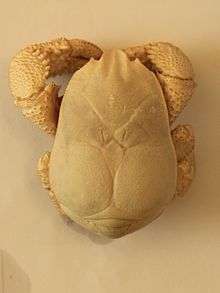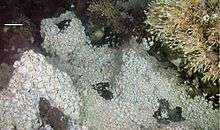Hoff crab
The "Hoff crab" (Kiwa tyleri) is a species of deep-sea squat lobster in the family Kiwaidae, which lives on hydrothermal vents near Antarctica.[1] The crustacean was given its English nickname in 2010 by UK deep-sea scientists aboard the RRS James Cook, owing to resemblance between its dense covering of setae on the ventral surface of the exoskeleton and the hairy chest of the actor David Hasselhoff.[2] The 2010 expedition to explore hydrothermal vents on the East Scotia Ridge was the second of three expeditions to the Southern Ocean by the UK led research consortium, ChEsSo (Chemosynthetic Ecosystems of the Southern Ocean).[3]
| Hoff crab | |
|---|---|
 | |
| Dorsal view of carapace showing distinctive markings | |
| Scientific classification | |
| Kingdom: | |
| Phylum: | |
| Subphylum: | |
| Class: | |
| Order: | |
| Family: | |
| Genus: | Kiwa |
| Species: | K. tyleri |
| Binomial name | |
| Kiwa tyleri Thatje S, Marsh L, Roterman CN, Mavrogordato MN, Linse K, 2015 | |
Distribution

This species – the only member of its genus found outside the Pacific Ocean, is known from two sites adjacent to and on the chimney sides of hydrothermal vents in the East Scotia Ridge of the south Atlantic Ocean: from around 2,394 metres (7,854 ft) depth at the E9 vent site and from around 2,608 m (8,556 ft) depth at the E2 site.[1]
Description
Phylogenetic analysis of the mitochondrial 16S ribosomal RNA gene and a range of other anomuran crustaceans, using Bayesian inference, places this species from the East Scotia Ridge as a sister taxon to Kiwa hirsuta, with a sequence divergence from this species of 6.45%, which is consistent for within-genus divergence in squat lobsters.[1]
Ecology

Unlike Kiwa hirsuta and Kiwa puravida, which are notable for having a dense covering of setae on their elongated chelae, this species has shorter chelae, with most of the setae concentrated instead on the ventral surface of the crab.[1]
Filamentous bacteria were found on the setae and similar-looking sulfur-oxidising bacteria have been found amongst the setae of Kiwa hirsuta and Kiwa puravida. It has been hypothesised that these sulfur-oxidising bacteria, which fix carbon from the water by oxidising sulfides in the hydrothermal fluid, are a significant source of nutrition to the crabs.[1][4][5]
The Hoff crabs were found living adjacent to and on the sides of hydrothermal vent chimneys living in close proximity to fluid emanating from the chimneys at temperatures greater than of 350 °C (662 °F). At E9, densities of the crabs were observed in excess of 600 per square metre (56 per square foot).[1]
Small limpets (a new species of Lepetodrilus) are often found on the carapace apparently grazing on bacteria.[1] Other marine fauna, such as sea anemones (family Actinostolidae), gastropods Gigantopelta chessoia, a species of stalked barnacle (most likely of the genus Vulcanolepas), a pycnogonid close to the genus Sericosura, and a predatory seven armed starfish can be found living together with this species.[1]
Media
The "Hoff crab" nickname was widely reported in the media whilst the species still lacked a binomial name,[6][7][8][9] and David Hasselhoff tweeted favourably in response to his "Hoff" moniker being used to describe a hydrothermal vent crab.[10][11]
The species was later given the binomial name Kiwa tyleri, after its discoverer, Paul Tyler of Southampton University.[12][13]
References
This article incorporates CC-BY-2.5 text from Rogers et al. (2012).
- Alex D. Rogers; Paul A. Tyler; Douglas P. Connelly; Jon T. Copley; Rachael James; Robert D. Larter; Katrin Linse; Rachel A. Mills; Alfredo Naveira Garabato; Richard D. Pancost; David A. Pearce; Nicholas V. C. Polunin; Christopher R. German; Timothy Shank; Philipp H. Boersch-Supan; Belinda J. Alker; Alfred Aquilina; Sarah A. Bennett; Andrew Clarke; Robert J. J. Dinley; Alastair G. C. Graham; Darryl R. H. Green; Jeffrey A. Hawkes; Laura Hepburn; Ana Hilario; Veerle A. I. Huvenne; Leigh Marsh; Eva Ramirez-Llodra; William D. K. Reid; Christopher N. Roterman; Christopher J. Sweeting; Sven Thatje; Katrin Zwirglmaier (2012). "The discovery of new deep-sea hydrothermal vent communities in the Southern Ocean and implications for biogeography". PLoS Biology. 10 (1): e1001234. doi:10.1371/journal.pbio.1001234. PMC 3250512. PMID 22235194.
- "'The Hoff' crab is new ocean find". BBC News. 4 January 2012.
- "ChEsSo – Exploration for vents south of the Polar Front". Archived from the original on 2012-05-27.
- Andrew R. Thurber; William J. Jones; Kareen Schnabel (2011). "Dancing for food in the deep sea: bacterial farming by a new species of yeti crab". PLoS ONE. 6 (11): e26243. doi:10.1371/journal.pone.0026243. PMC 3227565. PMID 22140426.
- E. Macpherson; W. Jones; M. Segonzac (2006). "A new squat lobster family of Galatheoidea (Crustacea, Decapoda, Anomura) from the hydrothermal vents of the Pacific-Antarctic Ridge" (PDF). Zoosystema. 27 (4): 709–723.
- "Near icy waters, marine life gets by swimmingly". NPR.
- "New crab with hairy chest dubbed "The Hoff"". CBS.
- "Unknown 'Hoff' crab species found". The Irish Times.
- "Weird & wild: 5 weirdest Antarctic species". National Geographic.
- "The Hoff, a yeti crab with a very hairy chest, discovered in deep sea vent". Huffington Post. 4 January 2012.
- "David Hasselhoff interview: 'failure usually works for me'". Huffington Post. 3 January 2012.
- "'Hoff crab' gets formal scientific name". BBC News. 25 June 2015. Retrieved 29 November 2017.
- Alex D. Rogers; Paul A. Tyler; Douglas P. Connelly; Jon T. Copley; Rachael James; et al. (2012). "The discovery of new deep-sea hydrothermal vent communities in the Southern Ocean and implications for biogeography". PLoS Biology. 10 (1): e1001234. doi:10.1371/journal.pbio.1001234. PMC 3250512. PMID 22235194.
External links
- Ghostly yeti crab swarms discovered near Antarctica, National Geographic YouTube Channel